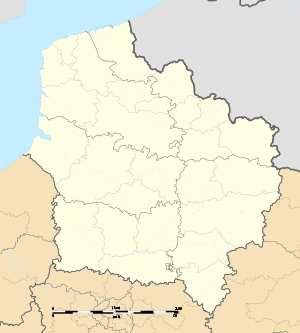Vitry-en-Artois
Vitry-en-Artois is a commune and in the Pas-de-Calais department in the Hauts-de-France region of France.
Vitry-en-Artois | |
|---|---|
The town hall of Vitry-en-Artois | |
Location of Vitry-en-Artois 
| |
 Vitry-en-Artois  Vitry-en-Artois | |
| Coordinates: 50°19′35″N 2°59′02″E | |
| Country | France |
| Region | Hauts-de-France |
| Department | Pas-de-Calais |
| Arrondissement | Arras |
| Canton | Brebières |
| Intercommunality | Osartis Marquion |
| Government | |
| • Mayor (2014-2020) | Pierre Georget |
| Area 1 | 18.78 km2 (7.25 sq mi) |
| Population (2017-01-01)[1] | 4,677 |
| • Density | 250/km2 (650/sq mi) |
| Time zone | UTC+01:00 (CET) |
| • Summer (DST) | UTC+02:00 (CEST) |
| INSEE/Postal code | 62865 /62490 |
| Elevation | 41–72 m (135–236 ft) (avg. 48 m or 157 ft) |
| 1 French Land Register data, which excludes lakes, ponds, glaciers > 1 km2 (0.386 sq mi or 247 acres) and river estuaries. | |
Geography
Vitry-en-Artois is situated some 12 miles (19.3 km) northeast of Arras, at the junction of the N50, D39 and the D42 roads. The river Scarpe flows through the town, which is also served by the SNCF railway. The World War II German airfield was later used by the Americans, then after the war, was put to commercial use as the local aerodrome.
History
The origin of the name comes from the Celtic, ‘’Vic’’ which means "castle" and ‘Ac’’ which means "at the water's edge". It appears later as "Victoriacum" mentioned in the 7th century. Middle stone age tools have been found in the area.
It was occupied by the Romans, until around the year 360 AD when Saint-Martin built a church here.
Aerial photography has revealed an isolated circular ditch monument at Vitry.[2] The Merovingian villa of Vitry was an important Neustrian seat, preferred to Arras. At Vitry, even as the nobles of Neustria were raising Sigibert I in triumph on his shield, he was murdered by hirelings of his brother Chilperic's third wife, Fredegunda, November–December 575.[3] His son, the infant Clotaire II was taken to safety from the palace at Cambrai to Vitry to be raised in seclusion and security, according to Gregory of Tours.
In the Middle Ages, Vitry became a strategic place, because the river could be used to flood the defensive border of the city of Douai and ensure the functioning of its windmills.
During the Franco-Prussian war of 1870–1871, French General Faidherbe briefly established his headquarters in Vitry-en-Artois (from 25 to 31 December 1870) after the battle of Pont-Noyelles.
During the First World War, the population took refuge in the network of shelters and tunnels of the town. The destruction sustained on April 12, 1917 left the town completely destroyed, with 768 buildings gone and only 5 left standing.
On 23 September 1920, the town received the Croix de guerre.
Population
| Year | 1962 | 1968 | 1975 | 1982 | 1990 | 1999 | 2006 | 2011 | 2015 |
|---|---|---|---|---|---|---|---|---|---|
| Population | 3389 | 3593 | 4748 | 4738 | 4732 | 4606 | 4385 | 4479 | 4631 |
| From the year 1962 on: No double counting—residents of multiple communes (e.g. students and military personnel) are counted only once. | |||||||||
Places of interest
- The church of St.Martin, rebuilt, along with much of the village, after World War I.
- The war memorial.
References
- "Populations légales 2017". INSEE. Retrieved 6 January 2020.
- Discoveries
- Gregory of Tours, IV.51 and V.1. He was buried nearby at Lambres before being transferred to the Neustrian sedes regiae at Soissons
External links
| Wikimedia Commons has media related to Vitry-en-Artois. |
- Vitry-en-Artois on the Quid website (in French)